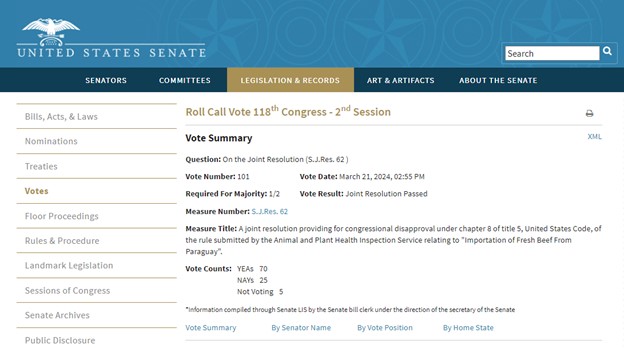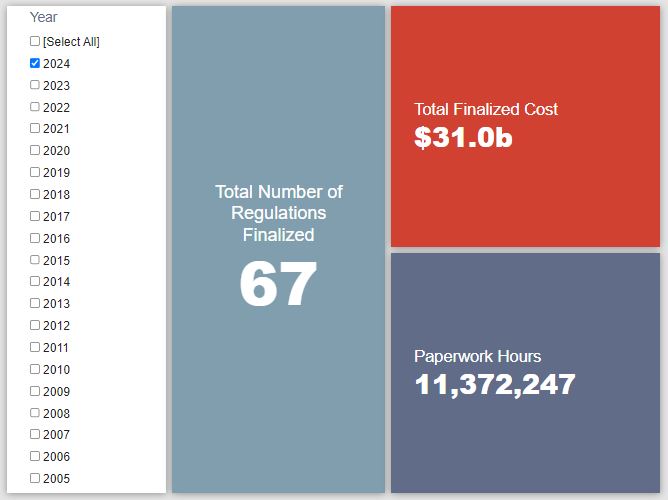Week in Regulation
March 25, 2024
Despite Major Tailpipe Rule, Quiet Week in the Federal Register
In terms of regulations that officially hit the books in the Federal Register, this past week was largely a dud. There were 10 rulemakings that contained some quantifiable economic impact, with only one crossing the $100-million threshold. The agency that the action came from – the Environmental Protection Agency (EPA) – certainly had its share of regulatory headlines this week, but those were largely for a rule whose formal publication date is still to be determined. Across all rulemakings, agencies published $244.2 million in total costs and added 34,121 annual paperwork burden hours.
REGULATORY TOPLINES
- Proposed Rules: 36
- Final Rules: 56
- 2024 Total Pages: 20,508
- 2024 Final Rule Costs: $31 billion
- 2024 Proposed Rule Costs: $31.7 billion
NOTABLE REGULATORY ACTIONS
In terms of rulemakings formally published in the Federal Register, last week’s most significant item was the proposed rule from EPA regarding “Revisions to Standards for the Open Burning/Open Detonation of Waste Explosives.” Despite such a banger of a title, the proposal is relatively modest and technical in nature. Essentially, based on “recent findings from the National Academy of Sciences, Engineering, and Medicine,” the agency is updating relevant regulatory code to “clarify and add specificity to existing requirements for owners/operators of OB/OD units, including how and when to apply and implement the requirements in the permitting process,” and to establish “new procedures for the permitting of mobile treatment units for waste explosives and new technical standards for OB/OD units.” EPA expects the annual costs involved with these new procedures to range from $6.3 million to $28 million annually, with a mid-point of $17.2 million (or nearly $200 million total in present value over a 20-year period).
In other EPA news, the agency also released the pre-publication version of its long-awaited greenhouse gas emissions standards for light-duty vehicles for model year 2027 onward. As with other rules of its size and scope, it may take some time for it to officially hit the pages of the Federal Register. Additionally, with hundreds of pages of accompanying analysis, there is plenty to examine in terms of its myriad impacts going forward. Initial American Action Forum (AAF) thoughts on the rule, however, can be found here.
TRACKING THE ADMINISTRATIONS
As we have already seen from executive orders and memos, the Biden Administration will surely provide plenty of contrasts with the Trump Administration on the regulatory front. And while there is a general expectation that the current administration will seek to broadly restore Obama-esque regulatory actions, there will also be areas where it charts its own course. Since the AAF RegRodeo data extend back to 2005, it is possible to provide weekly updates on how the top-level trends of President Biden’s regulatory record track with those of his two most recent predecessors. The following table provides the cumulative totals of final rules containing some quantified economic impact from each administration through this point in their respective terms.![]() With last week’s main rulemaking coming on the proposed rule side, there was limited movement in the Biden Administration’s to-date final rule tallies. Costs and paperwork increased by roughly $40.6 million and 160 hours, respectively. Across the other administrations covered here, the largest shift came during the Trump era. Thanks primarily to a Food & Drug Administration rule on warning labels for tobacco products, the Trump Administration’s final rule cost total increased by roughly $1 billion in March 2020.
With last week’s main rulemaking coming on the proposed rule side, there was limited movement in the Biden Administration’s to-date final rule tallies. Costs and paperwork increased by roughly $40.6 million and 160 hours, respectively. Across the other administrations covered here, the largest shift came during the Trump era. Thanks primarily to a Food & Drug Administration rule on warning labels for tobacco products, the Trump Administration’s final rule cost total increased by roughly $1 billion in March 2020.
THIS WEEK’S REGULATORY PICTURE
This week, the United States Senate had one of the more interesting votes in some time on a Congressional Review Act (CRA) resolution of disapproval. Source: Image pulled from Senate.gov
Source: Image pulled from Senate.gov
Last Thursday, as the accompanying image shows, the Senate passed S.J. Res 62 by a vote of 70-25. The joint resolution of disapproval would rescind a rule from the Department of Agriculture (USDA) regarding “Importation of Fresh Beef From Paraguay.” In the rule, the agency finds that: “Based on the evidence from a risk analysis, we have determined that fresh beef can safely be imported from Paraguay, provided certain conditions are met.” Rescinding the rule under the CRA would essentially obviate this determination and effectively restrict the importation of beef from Paraguay. Leaving aside the relative merits or demerits of the underlying rulemaking, this represents a highly peculiar instance in terms of the politics of the CRA.
As loyal followers of AAF’s CRA Tracker will likely appreciate, this represents a sizeable outlier in the regular course of CRA legislation. Thus far into the 118th Congress, CRA resolutions addressing nearly three dozen rules have been introduced, with at least one version passing through each chamber a dozen times. Most of these votes have largely fallen along party lines, with those successfully passing the Senate doing so on the most marginal of bipartisan majorities. Thus, even though these resolutions may pass through the currently Democratic-controlled Senate, they almost certainly stare down a veto from President Biden.
As noted elsewhere, however, this was the widest affirmative recorded vote for a CRA resolution of disapproval ever in the Senate, and most critically, a potentially veto-proof majority. It remains to be seen what a potential vote looks like in the House. The companion resolution in that chamber is technically bipartisan as well, but only nominally so with one Democratic cosponsor. Yet given the Senate margin, it is certainly within the realm of possibilities that the House passes it by a similar margin.
If it passes the House, it goes to President Biden’s desk for a final signature. If the president decides to veto the legislation, it is sent back to Congress for lawmakers to potentially override that veto by a two-thirds majority in each chamber. While the Senate vote from last week clears that threshold, it is still possible that a handful of senators will change their position on the override vote and sustain the president’s veto.
If they don’t? Well, then you have a quite novel situation where the CRA has finally been utilized to overturn an incumbent administration’s rulemaking despite having one chamber of Congress aligned with it on a partisan basis.
TOTAL BURDENS
Since January 1, the federal government has published $62.7 billion in total net costs (with $31 billion in new costs from finalized rules) and 29.4 million hours of net annual paperwork burden increases (with 11.4 million hours coming from final rules).










